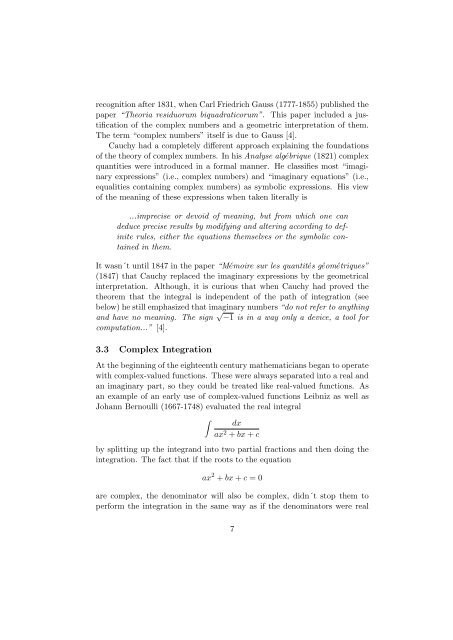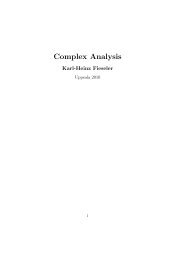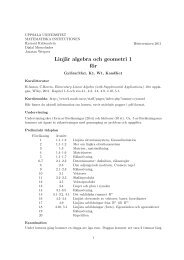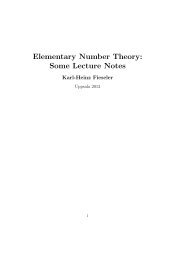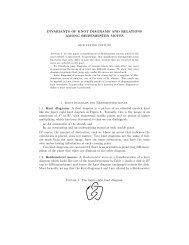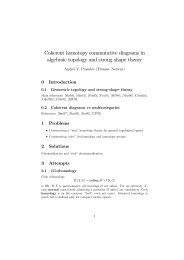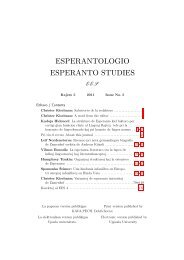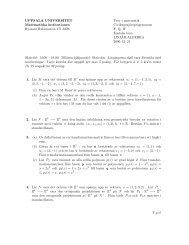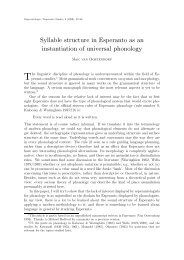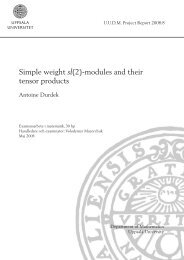Malmsten's Proof of the Integral Theorem
Malmsten's Proof of the Integral Theorem
Malmsten's Proof of the Integral Theorem
- No tags were found...
Create successful ePaper yourself
Turn your PDF publications into a flip-book with our unique Google optimized e-Paper software.
ecognition after 1831, when Carl Friedrich Gauss (1777-1855) published <strong>the</strong>paper “Theoria residuorum biquadraticorum”. This paper included a justification<strong>of</strong> <strong>the</strong> complex numbers and a geometric interpretation <strong>of</strong> <strong>the</strong>m.The term “complex numbers” itself is due to Gauss [4].Cauchy had a completely different approach explaining <strong>the</strong> foundations<strong>of</strong> <strong>the</strong> <strong>the</strong>ory <strong>of</strong> complex numbers. In his Analyse algébrique (1821) complexquantities were introduced in a formal manner. He classifies most “imaginaryexpressions” (i.e., complex numbers) and “imaginary equations” (i.e.,equalities containing complex numbers) as symbolic expressions. His view<strong>of</strong> <strong>the</strong> meaning <strong>of</strong> <strong>the</strong>se expressions when taken literally is...imprecise or devoid <strong>of</strong> meaning, but from which one candeduce precise results by modifying and altering according to definiterules, ei<strong>the</strong>r <strong>the</strong> equations <strong>the</strong>mselves or <strong>the</strong> symbolic containedin <strong>the</strong>m.It wasn´t until 1847 in <strong>the</strong> paper “Mémoire sur les quantités géométriques”(1847) that Cauchy replaced <strong>the</strong> imaginary expressions by <strong>the</strong> geometricalinterpretation. Although, it is curious that when Cauchy had proved <strong>the</strong><strong>the</strong>orem that <strong>the</strong> integral is independent <strong>of</strong> <strong>the</strong> path <strong>of</strong> integration (seebelow) he still emphasized that imaginary numbers “do not refer to anythingand have no meaning. The sign √ −1 is in a way only a device, a tool forcomputation...” [4].3.3 Complex IntegrationAt <strong>the</strong> beginning <strong>of</strong> <strong>the</strong> eighteenth century ma<strong>the</strong>maticians began to operatewith complex-valued functions. These were always separated into a real andan imaginary part, so <strong>the</strong>y could be treated like real-valued functions. Asan example <strong>of</strong> an early use <strong>of</strong> complex-valued functions Leibniz as well asJohann Bernoulli (1667-1748) evaluated <strong>the</strong> real integral∫dxax 2 + bx + cby splitting up <strong>the</strong> integrand into two partial fractions and <strong>the</strong>n doing <strong>the</strong>integration. The fact that if <strong>the</strong> roots to <strong>the</strong> equationax 2 + bx + c = 0are complex, <strong>the</strong> denominator will also be complex, didn´t stop <strong>the</strong>m toperform <strong>the</strong> integration in <strong>the</strong> same way as if <strong>the</strong> denominators were real7


